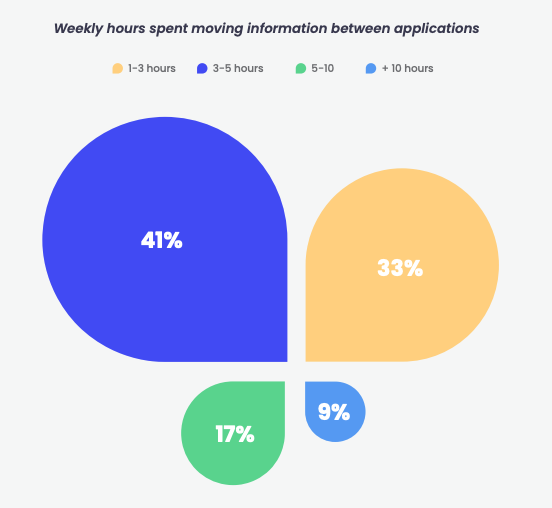Embedded integrations are table stakes for software vendors


Adam White
Content Marketing Associate @ Tray.io
If you work in software, API integrations for your product with your customers’ tech stack are no longer a nice-to-have. Your customers expect them.
“Embedded integrations”–integrations that software vendors offer with their own products to end customers’ other software tools–are table stakes for vendors and services teams, and are a non-negotiable requirement for building a successful product, attracting prospects, closing deals, and retaining customers.
Here's why: organizations across industries are facing the same challenges. Increasingly complex tech stacks consisting of apps that only offer rigid, limited integrations out of the box are causing your customers to rely on tedious manual workarounds, or they come to you to request integrations from your already overburdened engineers. But as you'll learn, embedding integrations using purpose-built solutions lets you avoid these headaches while improving customer satisfaction, increasing product stickiness, and reducing churn. Let's dive deeper into the reasons why you need to embed integrations in your product - then check out our Beginner's Guide to Embedded Integrations to learn more.
Why embedded integrations are table stakes for software vendors
Common integrations aren’t cutting it
Companies rely on hundreds if not thousands of different apps. Many of these are point solutions – applications that focus on executing a limited number of processes. For example, CRMs such as Salesforce, Microsoft Dynamics, and SugarCRM specialize in acting as a system of record for sales. Ticketing software like Zendesk or Help Scout support a range of customer support activities. While great for their intended purpose, they’re poor at connecting natively to other tools so that you can flow data across them as your business needs.
Many apps offer a few simple integrations to other popular applications, but these are often limited in their functionality and don’t allow any customization to fit specific requirements. As a result, your customers carry the burden of supporting integrations for their tech stack – and pass on their integration woes to software vendors, expecting new technology acquisitions to offer pre-built integrations to their many different tools from day one.
Accelerated digitization has led to bloated tech stacks
The integration challenge has only become more urgent in recent years. 90% of enterprise leaders are accelerating their digital transformation initiatives–the implementation of digital technology across an organization, especially with regards to migrating from legacy on-premise systems to the cloud.
Many companies have adopted cloud-based software, or SaaS, to help promote connection and collaboration among teams in an increasingly remote work environment, as well as to modernize their tech stack and give teams the power to respond more quickly to customers and provide improved customer experience (CX). In 2015, the average organization used around eight SaaS applications. In 2021, that number has grown to 1104.
An unintended consequence of increased SaaS adoption is the lack of native integrations between applications resulting in siloed data. As organizations across the globe continue to pursue digitization, they’re finding integration issues to be a top 5 challenge, with 39% of organizations reporting integrating technology as a top operational challenge.

Manual processes are killing your customers
You and your customers have the same goals: sell more of your products and services, edge out your competitors, and keep pace with changes in the market. But at the same time, your customers are feeling the pain of not having integrations to realize these outcomes. They’re trying to manage an ever-growing tech stack that silos data within individual apps–which means they have to resort to painful and time-consuming manual workarounds.
A recent survey of knowledge workers saw more than 90% of respondents resorting to manual spreadsheet work, hacking together a jury-rigged solution, or utilizing their own company’s limited IT resources to build something internally.
To make matters worse, the same report found that more than 60% of respondents spent more than three hours per week on manual data workarounds (with 26% spending more than five hours per week). In other words, your customers spend countless frustrated hours having to compensate for your product’s lack of integrations, rather than engaging productively with your product and gaining value. This is why, instead of using their own resources to bridge their gaps, customers are increasingly expecting interoperability between your software products and the key components of their tech stack, right out of the box.

Custom integration requests are killing your business
When your end customers request that your company build an integration from your product to another in their tech stack, your organization must make a conscious choice. Building an integration internally means diverting precious engineering resources and budget away from your roadmap, and away from developing a best-in-class product.
The trade-off may be worth it today to retain a high-value customer account, but your teams may feel the cost tomorrow. When your organization makes the call to build a one-off integration for a customer request, product or professional services teams get diverted from their core responsibilities, such as enhancing the core product or supporting new customers.
Worse still, building end-customer integrations isn’t a one-and-done job. Over time, various apps within your customers’ tech stacks will update their APIs, causing your homegrown integration to break. This means your customers expect your company to maintain the integration you just built in perpetuity. And you can multiply the maintenance burden by however many integrations your customers are already (and will continue to) ask for.
Product leaders, service teams, and developers use Tray Embedded to rapidly build integrations
Tray Embedded offers a visual, low-code interface that product, service, and dev teams can use to literally drag and drop together end customer integrations, so they can initially stand up, test, implement, and iterate on customer integrations significantly faster. They also perform API upkeep for various services to significantly reduce the burden of maintenance.
To learn more about embedded integrations, download our Beginner's Guide to Embedded Integrations.